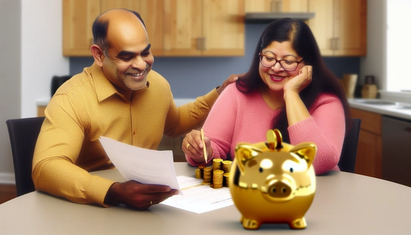When a Conventional Mortgage Doesn't Work: Alternatives
Written by:
Mike Tassone
Mike is a Co-Founder and Chief Operating Officer of Own Up. He has expertise in all areas of residential lending, having led operations for a top 40 lender in the United States.
See full bio

The dream of homeownership can become a reality if you have steady income, solid credit and tens of thousands in savings for a down payment. But that is a high bar for many individuals and families to meet. If that bar is too high, there are two main options: lower the bar, or seek counsel on how to better your financial situation. In 2005, lenders lowered the bar. During that time, loans had ominous nicknames like liar and exploding. These names referred to attributes including no-income verification and low-interest teaser rates that grew exponentially after an initial fixed rate period. That led to widespread foreclosures and a few years later, The Great Recession. What followed was a period where the loan approval bar was raised higher, locking more people out of homeownership.
This bar was codified into law in 2014 with the introduction of the Qualified Mortgage (QM) which sought to prevent borrowers from obtaining loans that were not affordable .As a result of this new rule, the private non-QM lending market grew from a small niche market in 2015 to an estimated $11 billion in 2018. One of the biggest exceptions that allows borrowers to qualify for a qualified mortgage come from the Government Sponsored Entity (GSE patch), which allows borrowers with higher debt-to-income ratios to qualify for loans backed by Fannie Mae and Freddie Mac although, the patch is set to expire in 2021. Without this patch, 16% of 2018 borrowers would have been unable to get a qualified mortgage.
This has the mortgage industry debating what mortgage requirements are appropriate. It also puts a spotlight on the alternative mortgage market, including both non-QM mortgage lenders and hard money lenders. These lenders are not offering the same products as those that led to mass foreclosures and the Great Recession, but their mortgage options differ from a conventional mortgage.
A Different Set of Terms
To understand what a non-QM mortgage or hard money loan is, the best place to start is by describing a qualified mortgage. By law, a qualified mortgage is one where borrowers are presumed to have the ability to repay and lenders are protected from litigation claiming they failed to verify the borrower’s ability to pay. A qualified mortgage meets the following conditions:
- The loan cannot have interest-only payments or balloon payments
- Total points and fees cannot exceed 3 percent of the loan (This is not closing costs, but only fees charged by the lender)
- The mortgage term must be 30 years or less
Some examples of non-QM loans offerings and borrower qualifications are:
- Loan-to-value ratios over 80%
- Credit scores as low as 600
- Interest-only loans
- Looser employment and income verification requirements
- Jumbo loans above conventional loan limits. The conventional loan limit for 2020 is $510,400 for single family homes.
- Higher interest rates
- Lower down payments
- Longer payment terms
- Higher fees
Hard money loans, on the other hand, are short term loans that are usually offered by private individuals or groups of investors and the lender uses the property as collateral. They require high down payments over 20 percent, they usually require the borrower to pay the lender money upfront (referred to as “points”), and they come with high interest rates. But they also have a quick turnaround for approval, generally require interest-only payments and have shorter terms. These loans are critical for real estate investors needing to jump on a deal or builders needing cash to get a project off the ground. For these projects, a long-term loan is not needed as once the property sells, money is available to pay off the balance.
Going the Non-QM Route
Non-QM loans are much less risky than the subprime loans that were offered before the housing bubble, but they should still be approached with caution. People who don’t easily qualify for conventional loans, but are financially stable, can consider going this route. Some specific scenarios where a non-QM loan might apply are:
- People with solid income but low credit because of a foreclosure in their recent past (foreclosures are not factored by lenders out after seven years)
- People who depend solely on self-employment income
- People whose previous home was sold in a short sale and who missed some mortgage payments leading up to the sale (if you did not miss payments, you might still qualify for a government-backed loan)
- Foreign nationals without extensive credit histories in this country
Here is a hypothetical example of a non-QM loan: Jane Doe is single, self-employed and has variable monthly income. She wants to live in her own house but minimize the monthly payments until she builds up her business.. She chooses non-QM mortgage with a 30-year-term but the first 10 years are interest only payments and the rate then adjusts. Her lender charges her two points as part of closing costs along with additional fees.
- Down payment of 20%: $40,000
- Closing cost and fees: $10,000 (including $4,000 in points)
- Balance: $160,000
- Interest rate year 1-10: 5%
- Term: 30-years with interest only in first 10 years
- Monthly mortgage payment for first 10 years: $666.67
- Interest rate at year 11: 6%
- Monthly payment of mortgage and interest: $1,003
- Total payments: $80,000 (first 10 years) + $240,720 (next 20 years)= $320,720
Had Jane Doe been able to pursue a conventional mortgage with a 30-year term and a fixed rate of 4% she would have $764 a month, or $275,040 in total. Closing costs are typically between 2 and 5 percent for a conventional mortgage, or $6,000 using an average. This means she paid almost $50,000 more for her loan through a non-QM lender. This shows why anyone who can qualify for a conventional loan should do so. Knowing what you are getting is critical to making the right decision.
Own Up specializes in working with people throughout the homeownership journey. A critical component of our mission is to educate borrowers so they are empowered to make choices that are in their best interests, not what’s best for the lender. Please contact us with any questions you have about the home buying process. We look forward to your call.


